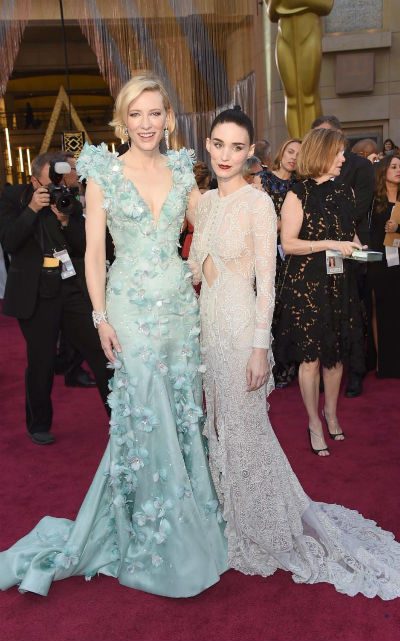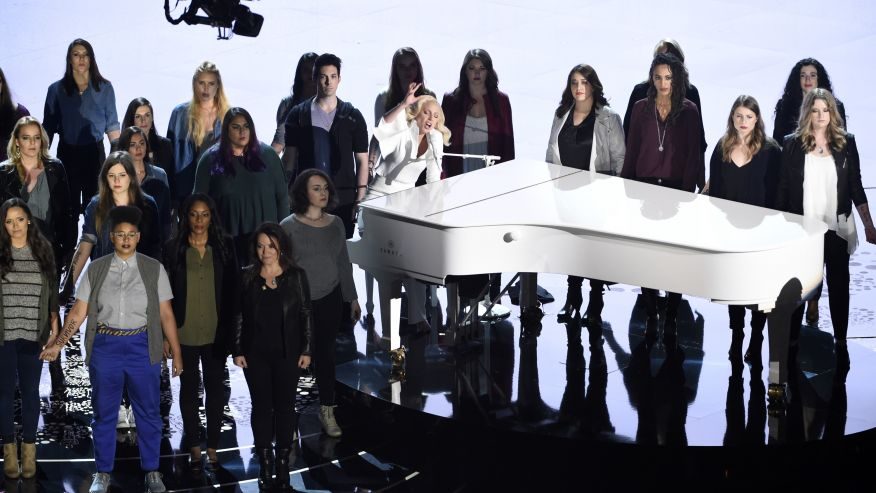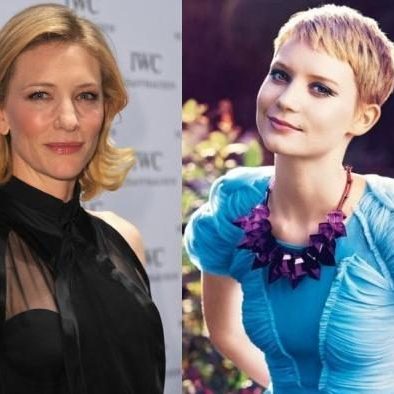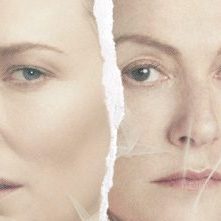
What about women at the Academy?
The Oscars are over for another year. We’ve dished the dresses – Cate Blanchett may not have won Best Actress for her beautifully nuanced performance as the eponymous lesbian in Carol, but she definitely won Best Dress for her magical, décolleté Armani Privé gown.
We’ve also dished–and dissed–the performances. For me, Lady Gaga gave the performance of her career with the haunting ballad “Till It Happens to You,” from the documentary The Hunting Ground, about campus sex assault. Most critics agree.
At the end of Gaga’s performance 50 survivors of campus rape came onto the stage, their arms raised up with messages like “survivor” and “unbreakable” written on them. It was one of the most emotional moments of a largely bloodless Oscars presentation and was introduced by Vice President Joe Biden calling on the audience to pledge to take a stand on consent and sexual assault. Groundbreaking stuff.
It was by far the most electrifying moment and one of only four standing ovations of the night. (The others went to Biden himself, Italian composer Ennio Morricone and Leonardo DiCaprio. Lady Gaga was the only woman to receive a standing ovation.)
Alas, in one of the more shocking upsets, Sam Smith won for Best Original Song, for his tepid Bond ballad, “Writings on the Wall.” Smith said, “I stand here tonight as a proud gay man, and I hope we can all stand together as equals one day.”
He dedicated his award to the “LGBT community all around the world,” which was sweet. But the rest of his speech garnered plenty of attention when he claimed to be the first openly gay man to ever win an Oscar.
Smith’s comment–doesn’t he have a Google app?–left me thinking about the history of the Oscars.
Smith was not the first openly gay man to win an Oscar, of course. There were many others before him–actually too many to cite here–which he should have known about. George Cukor was the first openly gay man to win an Oscar as Best Director in 1964 for My Fair Lady.
Sir John Gielgud won Best Actor in a Supporting Role in 1981 for his performance in Arthur. Pedro Almdóvar won twice: in 1999 for Best Foreign Language film for All About My Mother and in 2002 for Best Original Screenplay for Talk to Her.
Alan Ball, creator of TV’s True Blood series, won Best Original Screenplay for American Beauty. At the 81st Academy Awards seven years ago, Dustin Lance Black won Best Original Screenplay for Milk.
Even in his own category, Smith wasn’t the first out gay man. There have been numerous lyricists from Stephen Sondheim to Howard Ashman who have won. And Smith’s fellow Brit, Sir Elton John won an Oscar for 1994’s Best Original Song “Can You Feel the Love Tonight” from The Lion King.
Only one out lesbian has won an Oscar–notably Melissa Etheridge in 2006 for “I Need to Wake Up” from An Inconvenient Truth–but she won it in Smith’s category a decade before.
While there was much discussion of Smith’s gaffe and the role of gay men in the Oscars post-ceremony, the issue of the night was set long before Smith’s lapse set even straight people correcting his history.
Last year activist April Reign gave us #OscarsSoWhite, which drew immediate social media attention to the lack of diversity in the Academy Awards. Unfortunately, Reign had to resurrect it again this year when not a single actor of color was in any of the 20 best acting categories.
Reign, a former attorney and a writer and editor, told Huffington Post she created the hashtag to mock the lack of diversity at the award show. Her first tweet was “#OscarsSoWhite they asked to touch my hair,” a tweet every black person in America could relate to.
#OscarsSoWhite they asked to touch my hair. 😒
— April (@ReignOfApril) January 15, 2015
Within 24 hours Reign’s hashtag had gone viral. Within a week it was a movement. This year there was a concomitant boycott by notable black actors and director Spike Lee, whose film, “Chi-Raq” as well as its stellar black cast were snubbed by the Academy. (Lee has been nominated twice for Best Director and won an Honorary Academy Award in 2015 for his contributions to filmmaking.)
Did Reign’s work force the hand of the Academy? If it didn’t, it certainly pushed it hard.
The stunning lack of racial and ethnic diversity at the Oscars was highlighted by comedian Chris Rock, who hosted the 88thAcademy Awards ceremony on Feb. 28. Rock went there, directing pointed “jokes” at the majority white audience.
You could see the squirm–particularly when Rock suggested that there hadn’t been protests in the 1950s and 1960s over the lack of black actors and actresses being nominated by the Academy because “we were busy being raped and lynched.”
The audience wasn’t sure how they were supposed to respond, but there were a few gasps.
Nor were they sure how to respond to Cheryl Boone Isaacs, the President of the Academy of Motion Picture Arts and Sciences when she spoke about an hour into the ceremony. Boone Isaacs is the first African American to hold the position and only the third woman.
Boone Isaacs has instituted a policy of diversity which will move the 96% white, 83% male Academy into the 21st century with a more balanced electorate. Boone Isaacs put the onus on the audience–the work doesn’t happen at the Oscars, she said, it happens in hiring.
She echoed Rock who had said earlier that what was needed for black actors were the same opportunities that white actors get.
The bulk of media attention has been on the racial imbalance of the Oscars–which is staggering. The first black actor to ever be nominated for an acting award was also the first winner: Hattie McDaniel in 1939 for her role as Mammy in Gone with the Wind. In her acceptance speech she said she hoped she was a credit to her race.
It would be decades–1963–until Sidney Poitier became the second black actor to win an Oscar.
Only 18 black actors have been nominated for Best Actor and only four have won. The numbers are far worse for women: Only ten have been nominated for Best Actress and only one–Halle Berry in 2001,15 years ago–has won.
There have been 16 Best Supporting Actor nominations and four wins. But Morgan Freeman was nominated twice in this category after being nominated three times for Best Actor. Denzel Washington was nominated once and also three times for Best Actor. Freeman has one Oscar, Washington has two.
In the Best Supporting Actress category there have been 18 nominations and six wins.
Only three black directors have ever been nominated and none has won. All have been men.
As I watched the Oscars I was struck yet again by what a boys-only show it is. As bad as the numbers are for African Americans in the Academy, they are–incredibly–even worse for women of all races.
The first woman to be nominated for Best Director was Lina Wertmuller in 1976 for her film Seven Beauties. It was the first nomination for a women in 49 years. The next didn’t come until 1993 when Jane Campion was nominated for The Piano at the 66th Academy Awards.
That neither woman was even American–and the Oscars are an American venue–was striking. It took another decade for Sofia Coppola to be nominated for Lost in Translation. In 2009, Kathryn Bigelow became the first woman to win Best Director for her film The Hurt Locker, 82 years after the first Oscars.
No women have even been nominated in the years since, including Bigelow, whose film Zero Dark Thirty was nominated for Best Picture (and five other awards) at the 85th Academy Awards, even though she was not nominated for Best Director.

As bad as it is for women directors, it’s no better for women in the other categories. Which begs the question why there’s never been a boycott by women–or even a mention of any protest beyond the instigation last year of #AskHerMore about the red carpet treatment of women as fashion vehicles only.
There have been far more gay men than any women to win in the music categories. Three women have won–two composers: Rachel Portman, who won for Emma in 1996, and Anne Dudley, who won for The Full Monty in 1997. Lyricist Marilyn Bergman won for Yentl in 1983 in the Original Song Score category, but shared the award with composer Michel LeGrand.
The only female composers nominated for multiple Scoring Oscars are Angela Morley, who was nominated twice in the Original Song Score category for The Little Prince in 1974 and The Slipper and the Rose in 1976. Rachel Portman was nominated for Emma, for which she won for Best Original Score, The Cider House Rules in 1999 and Chocolat in 2000.
For contrast, John Williams alone has received 45 nominations.
No woman has ever even been nominated for Best Cinematography.
In 88 years, the first and only woman to win Best Animated Feature was Brenda Chapman in 2012 for Brave.
This year Sara Bennett became the first woman visual effects supervisor to win an Oscar, for Ex Machina. This is one of the areas in which women are virtually invisible and Bennett was the only woman on her visual effects team with whom she shared the Oscar. Only two other women have been nominated.
Women have done best in the screenplay categories. The first woman to be nominated for Best Original Screenplay was Joan Harrison in 1940.
The first woman to win was Muriel Box in 1946 with her husband. But the first woman to win solo wasn’t till Callie Kouri in 1991 for Thelma and Louise. Yet despite two dozen nominations, only eight women have won and none since Diablo Cody in 2007 for Juno.
Ten women have won the Best Adapted Screenplay award. The last to win the award was Diane Ossana with Larry McMurty for Brokeback Mountain in 2005. The woman with the most wins was Ruth Prawar Jhabvala.
This year there were two lesbians in the category–Phyllis Nagy for Carol, adapted from the Patricia Highsmith novel, and Emma Donoghue for Room, her novel of the same name. Neither won, but it was huge to have them there.
Film editing is one of the most important behind the camera roles in filmmaking, second only to directing and cinematography. It is also the category in which there have been the most women since Hollywood began making films.
This year three women were nominated–Maryann Brandon and Mary Jo Markey for Star Wars: The Force Awakens, the highest grossing film in 2015 and Margaret Sixel for Mad Max: Fury Road. Sixel won.
How many men and boys–or even women–know that two of the most male-centered films of the year were put together by women?
The first woman to win Best Picture–which is a producer’s award–wasn’t until Julia Phillips in 1973 for The Sting. She wasn’t just the first female winner, she was also the first female nominee.
There have only been eight women who have won for Best Picture. This year several women were up for the award–Mary Parent was one of the producers on The Revenant, Dede Gardner was one of the producers for The Big Short, Kristie Macosko Krieger one of the producers on Bridge of Spies, Finola Dwyer and Amanda Posey were the sole producers of Brooklyn.
Blye Pagon Faust and Nicole Rocklin made history with Spotlight, the first film with two female producers to win an Oscar.
And bizarrely, films directed by women have been nominated for Best Picture while the director herself has not been nominated. In 1984, for example, Barbra Streisand–a Hollywood legend and powerhouse and two-time Best Actress winner–wrote, produced, directed and starred in Yentl, which was heralded as an encoded lesbian film at the time.
She directed, produced and starred in The Prince of Tides, but while the film was nominated for Best Picture, it apparently made itself, because Streisand was not nominated for Best Director.
Nine other films directed by women have been nominated for Best Picture–while the director herself has not been nominated, most recently last year when Selma was nominated but the black woman director, Ava DuVernay, was not.
Among those films by women were the lesbian-themed The Kids Are All Right, for which Lisa Cholodenko was not nominated and Winter’s Bone, Jennifer Lawrence’s breakout film, for which Debra Granik was not nominated. Both Children of a Lesser God, directed by Randa Haines and Awakenings directed by Penny Marshall won other Oscars and were among the few films to address disability issues. But neither director made the nomination cut.
The lack of women in so many categories explains why I can list many gay male Oscar winners but only two out lesbians–Etheridge and Jodie Foster, who has won two Best Actress Oscars, but not when she was out.
Women have been relegated to the back burners of Hollywood for decades, even though, as I explained in my book Film Fatales: Independent Women Directors, written with filmmaker Judith M. Redding, women were at the forefront of the movie-making industry in the 1920s and 1930s as producers, directors, film editors and cinematographers.
And among them, of course, were lesbians and bisexuals, like Dorothy Arzner, who directed 25 films in as many years between 1919 and 1943 and Edith Head, the most famous costume designer in Hollywood history who worked on more than 1,000 films over her 60 year history and had affairs with notable actresses.
Oscar-winner Geena Davis, who has focused her own role at the Academy on raising consciousness about women in film, noted last year that women are silenced on film as much as if it were the 1920s and talk had yet to be invented.
Davis, who founded the Geena Davis Institute on Gender in Media noted in 2013 that data compiled by her Institute showed that “there are three male characters for every speaking female in family-rated [G, PG, PG-13] films. We are in effect enculturating kids from the very beginning to see women and girls as not taking up half of the space.”
What an extraordinary statement–and fact. (The research was conducted by Dr. Stacy Smith at the USC Annenberg School for Communication and Journalism.)
Davis noted the research indicated other alarming trends–and remember these are the films all kids are growing up with–”crowd and group scenes in these films–live-action and animated–contain only 17 percent female characters; and that the ratio of male-female characters has been exactly the same since 1946.
Throw in the hypersexualization of many of the female characters that are there, even in G-rated movies, and their lack of occupations and aspirations and you get the picture.”
Davis suggests it only takes two steps to change the narrative: Literally. And it’s the same challenge both Chris Rock and Cheryl Boone Isaacs demanded of their audience: put people of color in films, put women of all races in films.
If you have a crowd scene, says Davis, note in your script “half the crowd is female” If you have your list of characters set, go through and change half of them to women–including leads.
It’s so easy. Yet a century into the motion-picture industry people can make films on an iPhone, but they can’t manage to get women and actors of color on screen.
And so there we were at the 88th Oscars. There were more women nominated than usual in categories that are most often all male. Yet as always, women were still taking up less than half the space, even though we are 53% of the population and more than half the film audience.
Memo to Hollywood: Start making movies with women in the lead. It’s time.



